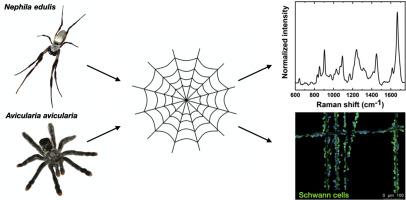Biomaterials Advances ( IF 5.5 ) Pub Date : 2020-06-20 , DOI: 10.1016/j.msec.2020.111219 Aida Naghilou 1 , Lena Pöttschacher 2 , Flavia Millesi 3 , Anda Mann 1 , Paul Supper 3 , Lorenz Semmler 3 , Tamara Weiss 3 , Ellen H G Backus 2 , Christine Radtke 4

|
The successful reconstruction of supercritical peripheral nerve injuries remains a major challenge in modern medicine. Progress in tissue engineering has enabled the development of nerve guidance conduits as an alternative to autologous nerve transplantation and the enrichment of conduits with fibrous materials or hydrogels has shown great potential in bridging nerve defects. The application of the dragline silk of spider genus Nephila as a filament for nerve guidance conduits has led to promising results. However, the use of spider silk has been phenomenological so far and the reasons for its success are still not identified. This renders a targeted tuning of synthetic fibrous luminal fillings such as recombinant silk out of reach.
In this work the existing research was extended and in addition to dragline, the cocoon silk of Nephila edulis, as well as the connecting and attaching silk of Avicularia avicularia were investigated. Scanning electron microscopy revealed a difference in size and morphology of the spider silks. However, in vitro experiments indicated that Schwann cells adhere to the four fibers, independent of these two attributes. Raman spectroscopy in native state and aqueous environment demonstrated similar secondary protein structures for dragline, cocoon, and connecting silk. In contrast, the attaching silk showed a significant lower conformation of β-sheets, crucial for the stiffness of the silk. This was in line with the in vitro experiments, where the flexible attaching silk fibers adhered to each other when placed in liquid. This resulted in their inability to guide Schwann cells, leading to the generation of cell agglomerations. This direct comparison demonstrated the crucial role of β-sheets conformation for the guidance properties of natural spider silk, providing essential insights into the necessary material properties for the integration of fibrous luminal fillings in nerve guidance conduits.
中文翻译:

将天然蜘蛛丝的二级蛋白质结构与其对雪旺细胞的指导性质相关联。
成功重建超临界周围神经损伤仍然是现代医学中的主要挑战。组织工程学的进步已使神经引导导管的发展成为自体神经移植的替代方法,并且用纤维材料或水凝胶富集导管已显示出弥合神经缺损的巨大潜力。蜘蛛状Nephila的拉丝牵引丝作为神经引导导管的丝的应用已产生了可喜的结果。然而,到目前为止,蜘蛛丝的使用一直是现象学的,其成功的原因仍未确定。这使合成纤维状腔内填充物(如重组丝)的目标调节变得遥不可及。
在这项工作中,对现有研究进行了扩展,除拉铲之外,还对可食Nephila edulis的茧丝以及Avicularia avicularia的连接和附着丝进行了研究。扫描电子显微镜显示蜘蛛丝的尺寸和形态不同。但是,体外实验表明,雪旺细胞粘附于这四根纤维,而与这两个属性无关。拉曼光谱在天然状态和水性环境下显示出相似的二级蛋白质结构,适用于拉铲,茧和连接丝。相反,附着的丝显示出明显较低的β-折叠构象,这对丝的刚度至关重要。这符合体外实验中,将柔软的蚕丝纤维置于液体中时会相互粘合。这导致它们无法引导雪旺氏细胞,导致细胞团聚的产生。这种直接的比较证明了β-折叠构象对于天然蜘蛛丝的引导特性的关键作用,从而为将纤维腔填充物整合到神经引导导管中所必需的材料特性提供了重要见解。











































 京公网安备 11010802027423号
京公网安备 11010802027423号